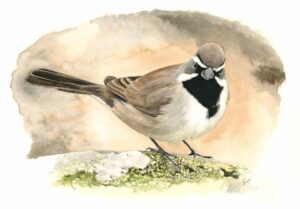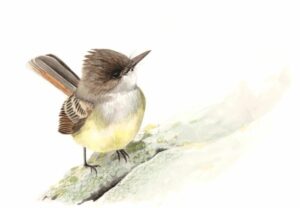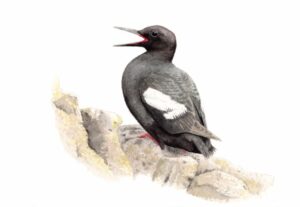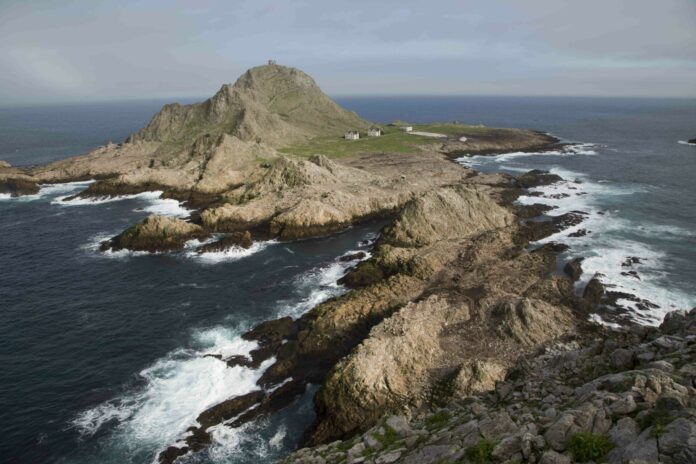Life on the Farallon Islands National Wildlife Refuge.
by Erica Messner
As we approach the Farallones, the distant islands grow incrementally larger, and then, all at once, they are looming. Western gulls soar overhead, their cries carrying over the surf. Sugarloaf, the towering gray-brown rock ahead, is covered in pelicans and cormorants. As we enter the cove, I smell and hear the sea lions before I see them, brown bodies piled onto the lower rocks. I ask one of our naturalist guides, David, if you ever get used to the smell. That, he tells me, is the sign of plentiful food and a productive marine habitat—it’s the life force of the place we’re smelling. I see more evidence of a productive marine ecosystem staining the rocks in rivulets down to the sea. White guano means the birds are eating mostly anchovies. Pink means krill.
“The Farallones are some of the very best-preserved islands,” our other guide, Roger, tells me. “They give you a glimpse into what the pristine state may have looked like before we became the dominant species.”
The Farallones are ruled by seabirds, especially during breeding season in the spring. A quarter of all of California’s marine birds are born on the islands, making this small rocky outcropping the largest seabird rookery in the contiguous United States.
“There’s not one spot you can find on the islands during the breeding season where, if you sat down, you would not be sitting on an animal. It’s just very dense with wildlife,” Roger says.
The Farallon Islands National Wildlife Refuge is monitored by the nonprofit Point Blue Conservation Science under a cooperative agreement with the U.S. Fish and Wildlife Service. I learn from Pete Warzybok, the Farallon program leader, that Point Blue has maintained a continuous presence on the Southeast Island since 1968, with biologists and volunteers living and working there 365 days a year. The South, Middle, and North Farallon Islands are spread out over five miles of ocean, with a combined land area of 0.16 mile. Only the Southeast Island is inhabited by humans. Warzybok himself has spent more time on the Farallones than nearly any other person. String all the days together, and he’s lived there for more than six years.
“It’s a very distant and isolated environment,” he says. “On many days, you can’t see the mainland from the island, and you can’t see the islands from the mainland. Half the population of San Francisco doesn’t even know we’re out there.”
The Farallon Islands are officially part of the city of San Francisco, but as a protected wildlife refuge, they are not open to the public. Only a handful of select volunteers and scientists can set foot on the salty, smelly gray rocks of the Southeast Island, and the small crew is vastly outnumbered—by hundreds of thousands of birds.
. . .
Over on the mainland, where I live, much of San Francisco had been closed to the public for months, as local governments attempted to limit the spread of COVID-19. The first quiet moments of the City’s shelter-in-place mandate had been unnerving. Humans and their conveyances had disappeared overnight. Walking down deserted city streets, I had the prickly feeling I was trespassing.

In those initial months, with the volume of human activity dialed down in the Bay Area, ornithologists found that local white-crowned sparrows were singing more intricate, greater-bandwidth songs. Birdsong can travel longer distances absent human noise pollution, and the sparrows took advantage, singing a wider variety of high and low notes to communicate warnings and impress potential mates. On my block, the flourishing of avian life was a little disconcerting, as if all of my neighbors and delivery drivers had turned into tiny, fluttering, chatty creatures.
An “anthropause” is what some scientists called this moment when governments shut down travel and businesses in response to the pandemic. While the respite provided a temporarily less filtered view of the natural world, the consequences of pausing human activity were more complex than they may have initially seemed. There are sanctuaries and wildlife rehabilitation centers around the world that depend on tourism dollars. Endangered species require protection from poaching. And delicate habitat restoration and refuge management (like on the Farallones) need consistent monitoring and maintenance.
Traffic slowly returned as the lockdown eased. The sidewalks grew busier as neighbors cautiously ventured from their homes. Newly attuned to my surroundings, I continued to watch for birds, in the rustling leaves of dense bottlebrush trees or soaring high above Dolores Park. I was surprised and delighted by how much there still was to notice.
As fall rolled around, my thoughts turned to the Farallon Islands, where, I’d heard, humans had found an entirely different way to coexist with birds. I decided it was time to put my own pandemic-induced isolation in perspective with a fifty-plus-mile round-trip sea voyage.
Needless to say, I had not picked an opportune time to become suddenly interested in the most inaccessible place in San Francisco. Early on in the pandemic, most tour companies, like everything else, had been shut down. Then they were operating at half-capacity and booked for the entirety of the late-summer-into-fall whale watching season. Still, one Friday afternoon in November, I got lucky and spotted a cancellation online for the next day. I signed up for the last Oceanic Society trip of the year.
The following Saturday, I board the Salty Lady in Sausalito, swaddled in layers appropriate for an eight-hour sea voyage of indeterminate weather conditions. Our guides are David Wimpfheimer and Roger Harris, two seasoned naturalists with a combined longer-than-I’ve-been-alive years of experience leading tours to the Farallones.
We maneuver our way out of the harbor, waving to seals hauled out on the dock and dodging numerous paddleboarders and kayakers. We slip under the Golden Gate Bridge, motor a quick detour up to Point Diablo, and then sail out past Point Bonita Lighthouse at the southwestern tip of Marin County, the final beacon of the Golden Gate.
Our boat cuts a straight line through gentle swells. The mainland flattens behind us. Gulls dive and rise in our wake. It’s a glorious day as we sail westward: a dusty blue sky with the faintest paintbrush clouds, clear enough that Sutro Tower is visible all the way out. The ocean opens before us, a gleaming iridescent blue like crumpled cellophane.
The other passengers are masked up and trying their best to social-distance. A group standing behind me asks the best questions, like “Has anyone ever gone overboard?” (Not on our guides’ watch, but yes, and while escapees get picked up pretty quickly, falling into the frigid waters is definitely not recommended); and “Have you seen any shark attacks?” (Just last season, our guide witnessed a gory one, and even made eye contact with the poor elephant seal–turned–shark meal.) At least one passenger spends the majority of the trip in the cabin bathroom, while her husband, fancy camera in tow, paces nervously outside. I experience a moment myself, hunched over my notebook, when the inside of my stomach turns about ten degrees hotter, like I’ve swallowed a hot, heavy rock. It is not easy to take notes on even a gently pitching boat with even a mild case of seasickness. I record a voice memo with my observations and go out to sit on the bow.
The thirty-mile journey takes a little over two hours.
. . .
In inclement weather, unlike on our calm autumn day, crossing from the mainland is dangerous and sometimes impossible.
“A winter storm comes through and you have twenty-five-foot waves crashing up onto the island, and wind whipping the rain at you sideways at fifty miles an hour. It can be a very harsh environment, but it’s also incredibly beautiful,” Warzybok tells me over the phone a few days later.
It takes a certain type, yet both Warzybok and Roger describe the islands as their favorite place. “Those of us who do find our way to this kind of thing, it just seems natural,” Warzybok says.
From the boat, I watch seals play in the water, stopping to peer at us curiously. Black and white common murres dive deep, fishing in one of the most productive marine environments in the world. As we drift toward piles of sea lions and a dozen camera shutters click in recognition, I experience an echo of the strange feeling I first felt during the lockdown: that slight sense of intrusion.
“As a researcher out there, you learn fairly quickly that the island belongs to the wildlife and you’re just a visitor. You’re tolerated by the wildlife as long as you’re not causing problems. But you’re not really part of the system,” Warzybok says. “It’s amazing to be able to live in a system and observe it and learn from it while having very little impact on it, and those kinds of situations are very uncommon.”
It’s a rare opportunity, and one that is even more exclusive during the pandemic. Since March 2020, crews on the island have been limited to no more than five people (instead of the usual eight), supply boats come once a month (instead of every other week), and volunteers are mostly spending three to four months at a time on the island, forgoing the typical two-week break in the middle.
I manage to catch Point Blue volunteer Evan Lipton the day after he returns from a three-and-a-half-month stay on the island. We meet in Bolinas, the notoriously hard-to-find hamlet northwest of Stinson Beach. After a couple of wrong turns, I drive up to find him on the beach with binoculars, watching the shorebirds.
I ask him whether he’s feeling any culture shock. “Yeah, it was weird to see trees again, for about five minutes,” Lipton says. There are only three trees on the island. Traveling to meet me is also the first time in several months that he has driven a car. Another big shock is the smell of fresh, clear air.
“The rocks are looking very, very familiar by the end,” he says. “But there is so much going on. There’s so much to look at—even on the foggy days when there were barely any birds around and nothing new was on the island, just watching the sea lions and elephant seals and harbor seals.”
And great white sharks. Every day in the fall, a couple of volunteers head to a high point on the Southeast Island, stand on the cement platform that supports the lighthouse, and scan the ocean. They’re looking for the predators’ telltale signs: circling gulls, an oil slick, or a blood pool.
“Often, if [the attack] is happening right then, you’ll see the shark’s dorsal fin and the caudal fin thrashing around as the shark comes up. It’ll latch onto the prey and thrash back and forth to saw the carcass apart,” Lipton says.
The sharks’ most common prey are the elephant seals that breed on the islands, which are larger and not as nimble as other seals. “Most of these shark attacks only last five minutes. That’s how long it takes a shark to eat an entire seal,” Lipton says. It sounds brutal, but shark attacks near the Farallones are a good thing—a sign of a healthy food web.
Volunteers are stationed on the island to make detailed observations of wildlife: shark watch, seal and sea lion life, and daily area surveys of the birds. They reside in an old Victorian built for lighthouse keepers in the late 1800s. (From the boat, we had glimpsed two of the island’s houses sitting side by side in a field on the flat part of the island, one tree next to each, like a micro suburb.) There’s camaraderie among the crew, being they are the only five people in a thirty-mile radius. Volunteers rotate dinner duty, getting creative between supply boats. “We eat very well on the island,” Lipton says. He described one dinner he made—stuffed mushrooms with vegetable soup—that put my daily pandemic cooking to shame.
Lipton’s focus was on the migratory birds that visit the island. Land birds tend to arrive at night, migrating in the dark to avoid predators. A little after sunrise, they would begin falling out of the sky, alighting on the island as the only viable land mass for miles, especially when fog obscured the mainland. The volunteers began their day with an area survey—counting and banding birds. The crew tallied how many of each species showed up each day and how long they stayed, while taking measurements of their health.

Some songbirds can double in weight prior to migration, turning almost spherical, with layers of fat concentrated around their necks and breasts and under their wings. Researchers measure the fat by capturing the birds in mist nets, picking them up, and gently blowing on the birds’ breasts, moving their feathers to observe the color beneath the birds’ translucent skin: fat is yellow and muscle is pink. The volunteers also conduct a shorebird survey, looking along the edge of the island for turnstones, oystercatchers, plovers, and sandpipers. At night, the crew takes a survey of the gulls coming in to roost.
As we walk along the beach in Bolinas, Lipton shares details about the shorebirds, seabirds, and raptors that frequent there. He points to a group of marbled godwits, their long bills ending in a prehensile tip, a feature shared by many shorebirds. “When you stick a bill like that all the way into the ground, there’s so much pressure that you can’t open it,” he explains. Instead the birds open the tip, grab a worm or insect, and pull it up. The godwits are here for the winter. In spring they’ll head back to their breeding grounds in the Great Plains.
He points out a Heermann’s gull, known for its bright red beak during breeding season. Heermann’s gulls have a habit of following around pelicans and stealing their fish. “They’ll even go so far as to reach their heads into the bill of the brown pelican and pull fish out,” Lipton tells me. Kleptoparasitism, it’s called.
Sheltering in place has reminded me of the pleasure of looking closely at the familiar—the multitudes contained in a city block or a patch of green space. Talking with Lipton, I realize I’ve barely scratched the surface.
“That’s one of the amazing things about birding. You can get so lost in even a single species. Their life history is so intricate,” he says. “I try to think about what I thought before I started birding and I don’t remember anything. Now pretty much most of the things that I think about the world revolve around birds,” he says.
. . .
Back on the Salty Lady, we round a bend, and tightly packed onto the cliffside are hundreds of common murres, black-and-white birds that look a bit like small penguins. We get a call on the radio from the Farallon crew, telling us the murres just showed up that morning, grouping close together on the rock as they usually do only in breeding season.
The murres are a symbol of the islands’ recovery from the abuse of previous generations of humans. During the gold rush, egg harvesting on the island decimated the murre population. They’ve only fully bounced back in the past couple of decades with careful management. Conservationists have passed regulations to eliminate gill net fisheries and have worked to improve containment on tankers to reduce the number of oil spills, Warzybok tells me. With murre habitat protected from the worst forms of human encroachment, the population has made an incredible recovery.
“In the twenty years that I’ve been working on the Farallones, it’s gone from a little over 60,000 murres to now almost 300,000. And that’s largely due to human intervention and management,” Warzybok says.
But for other species on the island, like the Cassin’s auklet, which is more specialized to its environment and more sensitive to disturbances, it may not be enough to protect and preserve only this essential area of habitat. Cassin’s auklets feast on krill brought to the Gulf of the Farallones by seasonal upwelling—nutrient-rich deep water off the continental shelf is upwelled by winds and then carried north in the California Current to fuel an entire food web. The increase of warming events like marine heat waves affects the auklet population due to their limited range and specific diet. Species like the Cassin’s auklets may be the proverbial canaries in the coal mine.

“It’s a little weird getting into this sort of work nowadays, when a lot of the people I’m working with, or even older birders that I know, are always talking about how many birds there used to be, and how amazing it used to be, and how few birds there are now in comparison,” Lipton told me. “In a way I’m thankful I didn’t experience that, so I can’t miss it with as strong feelings as other people do.” According to a 2019 study published in Science, North America has lost three billion birds over the past fifty years, a nearly thirty percent reduction.
. . .
As our boat turns back toward the mainland, leaving the Farallones silhouetted against the setting sun, I consider the wildlife refuge in context, this crucial sanctuary humans have preserved. Our relationship with the natural world strikes me differently here than it has in other settings. In Yosemite, for example, with its walls of towering granite and miles and miles of backcountry, it’s easy to feel small in the face of the power of nature, to feel insignificant. But here, I feel the fragility and resilience of nature alongside the impact and responsibility humans have.
It is humans who hunted fur seals to extirpation (local extinction) in the 1830s, who stole or smashed hundreds of thousands of murre eggs to feed San Francisco’s forty-niners. And yet it is also humans who set aside these islands for protection in perpetuity, who ratified the Migratory Bird Treaty Act in 1917 and the Marine Mammal Protection Act in 1972, and who now serve as perpetual stewards of the islands. We have transformed from enemy to ally. Yet even as we continue to defend this delicate ecosystem, on a larger scale, our species is still on the attack.
“It’s well established that climate change is impacting all aspects of our lives and of the natural world. And on the Farallones, with our long-term data, we can see the impacts it’s having,” Warzybok said. “I worry about whether we have the collective political and emotional will to make the changes that are necessary. I think that the science, not just that we do but that is done by climate scientists around the world, is very compelling and very clear about what needs to be done in terms of reducing emissions and allowing the natural world to recover. My fear is finding a way to make that happen.”
Back on the mainland, faced with the threat of the pandemic, we’ve had to ask ourselves a similar question: when protecting our community requires collective, organized action, can we do it?
Meanwhile, the larger global challenge has not disappeared: to find a sustainable balance between humans and the natural world, to ensure the survival of our planet. In the same way, we must ask ourselves, do we have the political will, the empathy, and the sense of communal purpose to act together, with intention, and bring about change?
I hope so, and frankly, I don’t think we have a choice.
When I start to have doubts, I think of the small group of biologists and volunteers stationed alone on a tiny, essential island, fiercely defending and studying an ecosystem we’re only beginning to understand. Waves pound the shore, and the wind picks up. ♦
Erica Messner is cofounder and editor in chief of The San Franciscan. On a sunny day, when she’s not writing, you can find her climbing stairways and taking pictures of Sutro Tower. She lives on a hill in the City by the Bay.
Evan Lipton is a field biologist and an illustrator from Massachusetts. He spent the majority of 2020 working for Point Blue Conservation Science on a couple of their long-term avian monitoring projects in the Bay Area. He spends most of his waking hours watching, photographing, or thinking about birds.



